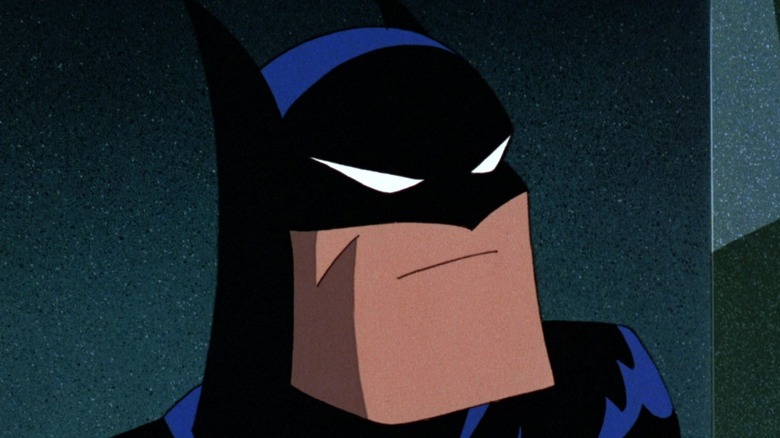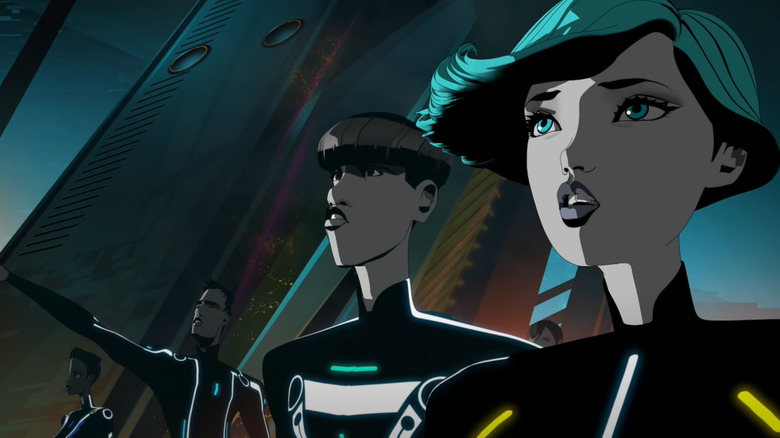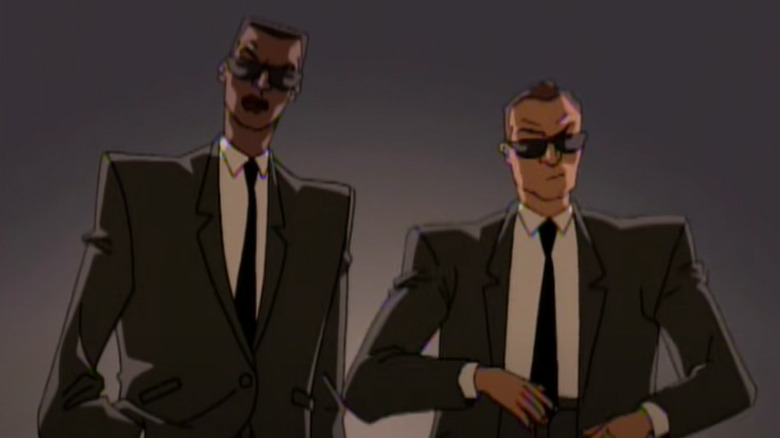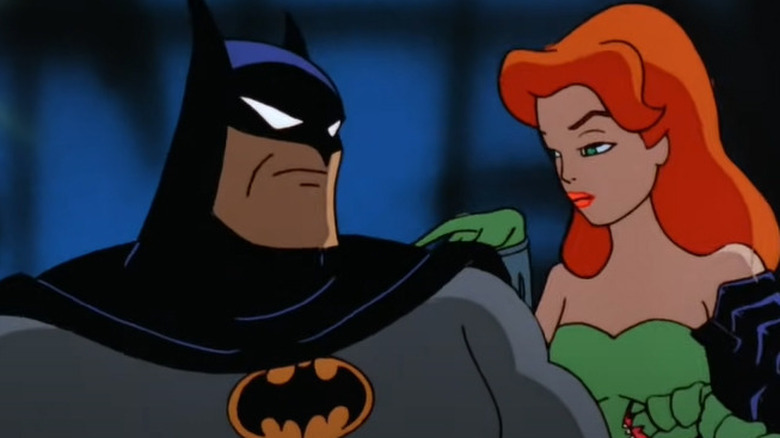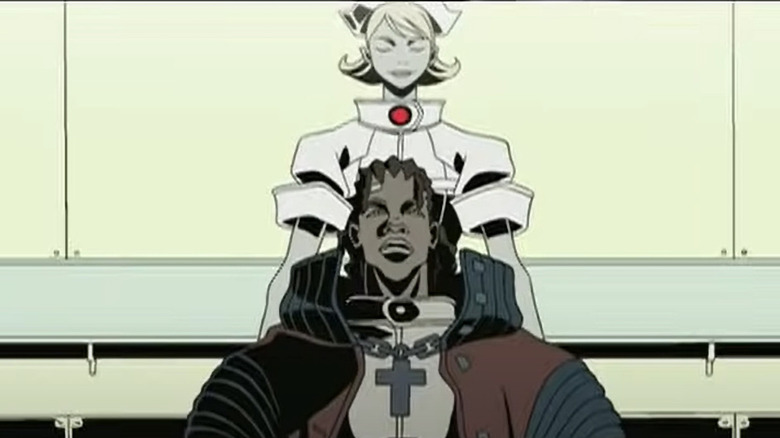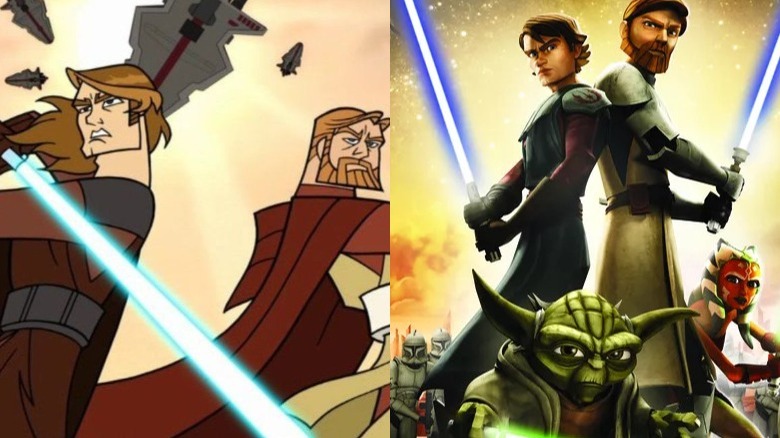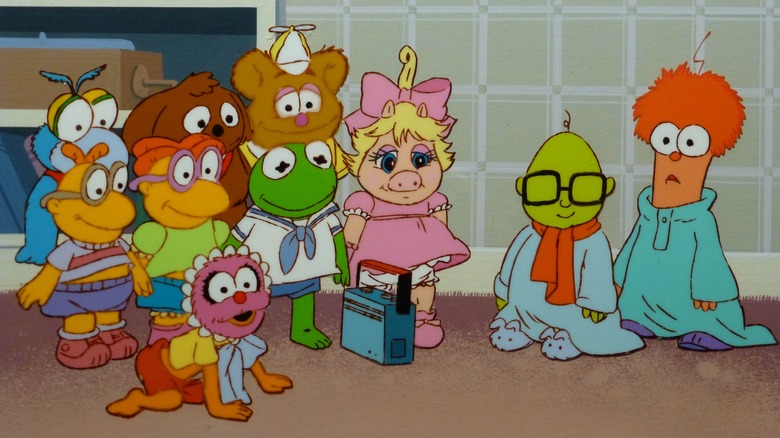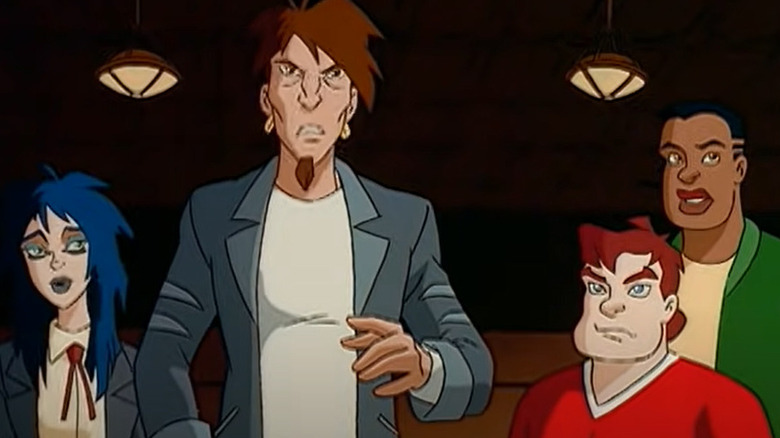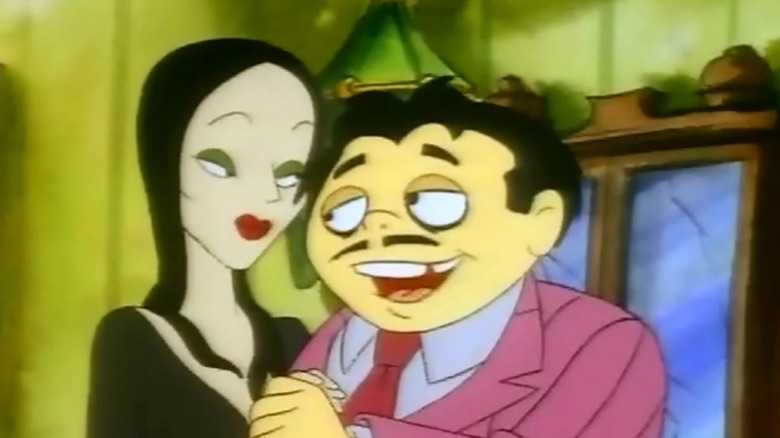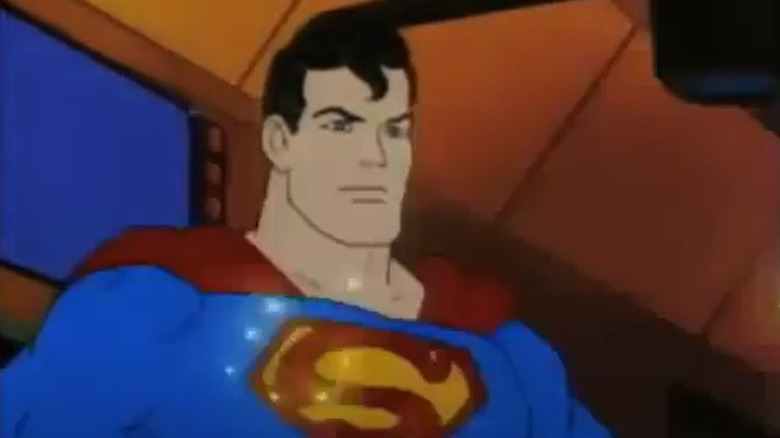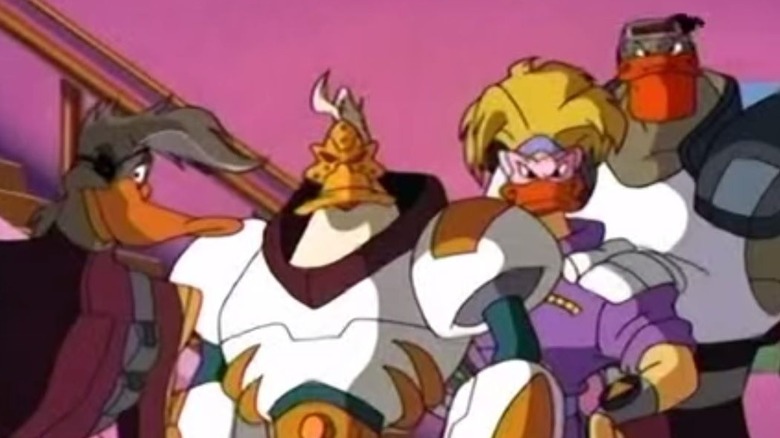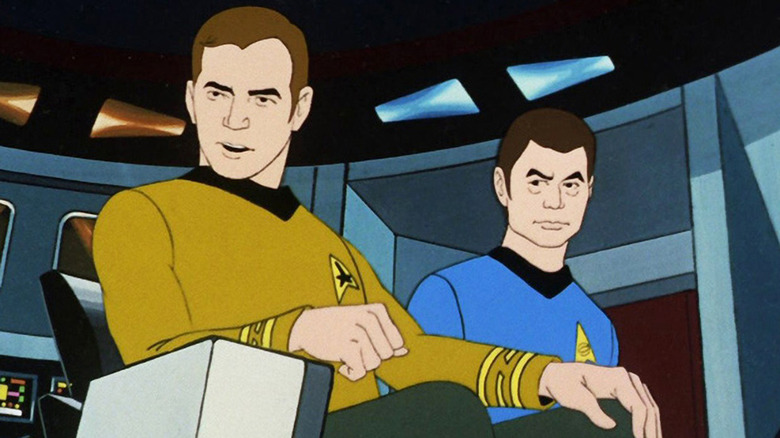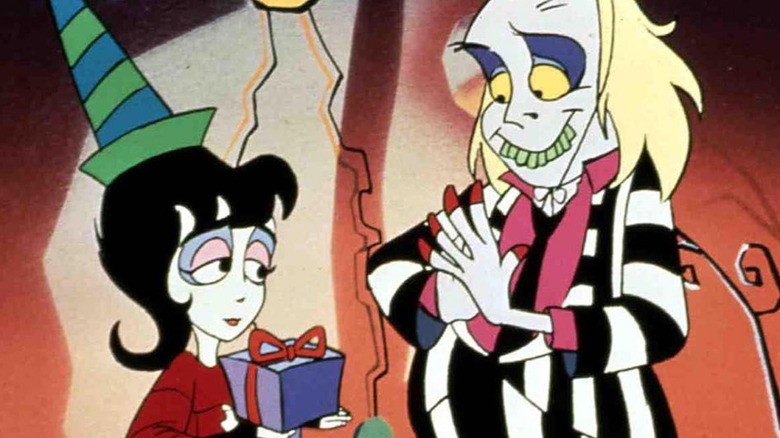The Best Animated Versions Of Live-Action Movies And TV Shows
What happens when a live-action TV show or film takes off and viewers want more? Sometimes, sequels and subsequent seasons are made. Other times, however, studios opt for an animated solution. Even the most devoted pop culture aficionado might be surprised to learn just how many animated versions of live-action properties exist: Everything from "Emergency!" to "Free Willy" to "Bill and Ted's Excellent Adventure" has gotten its own cartoon. Some adhere closely to their source material, while others take a looser approach.
Sadly, not every animated take on beloved live-action productions is a winner. Yet for every flop that hits the big or small screen, there's at least one other cartoon that ends up matching, or even surpassing, the original live-action material — even when it's not entirely faithful to it. From "Batman: The Animated Series" to "Extreme Ghostbusters," these are the very best animated versions of live-action movies and TV shows.
Tron: Uprising fills the gap between the two Tron movies
One of the most surprising things about 2010's "Tron: Legacy," the sequel to 1982 special effects watershed "Tron," is just how reduced the titular character's role is, compared to the first movie. "Tron: Uprising," which hit the small screen in 2012, makes up for this departure by not only bringing Tron himself back to prominence, but also introducing his potential successor, Beck. A "teenage" mechanic program (reminiscent of Sam Flynn in "Legacy"), he poses as the original Tron, aka his mentor.
This CGI series exceeds expectations with dazzling effects and spectacular fight sequences, as well as a compelling storyline containing plenty of twists and mythology-building. It's hard not to be reminded of "Batman Beyond" while watching: Beck comes off as a more serious version of Terry McGinnis, while Tron recalls either Bruce Wayne at his most compassionate or most extreme, depending on the situation. The A-list cast, featuring Elijah Wood (Beck), Mandy Moore, Emmanuelle Chriqui (Paige), and of course, Bruce Boxleitner reprising his role as Tron, doesn't hurt either. Sadly, "Tron: Uprising" was canceled before it could complete its story. Yet it remains a strong companion piece to both "Tron" movies, particularly the second: While "Tron: Legacy" continues the story of the franchise's other major male lead, Kevin Flynn, "Uprising" further chronicles Tron's saga. Watching them both creates a fuller picture of what happens after the first "Tron" ends.
Men in Black: The Series is everything the sequels could have been
Not many people know that the "Men in Black" saga actually started as a comic book with a more generalized focus on the paranormal. Ultimately, of course, it was 1997's alien-centric "Men in Black," starring Will Smith and Tommy Lee Jones, that really brought the franchise into the public eye. An animated series soon followed, simply titled "Men in Black: The Series," which is set in a similar universe as the original movie, albeit one where Agent K apparently never retired. The show follows K and J as they continue handling extraterrestrial affairs and threats on Earth, earning a whole lot of laughs along the way.
With regular appearances from Agent L, Zed, and aliens like Frank the Pug and the Annelids (aka "the Worms"), this intelligently written show feels like a natural continuation of the first movie. Season 2 even crafts a sort-of sequel by having members of movie villain Edgar the Bug's species (all voiced by Edgar's on-screen actor, Vincent D'Onofrio) hunt Agent L for murdering their kinsman. Perhaps most impressively, this cartoon introduces widely-embraced additions to the mythos, including K's infamous mentor, Alpha. Though the "Men in Black" sequel films have never looked to the cartoon for inspiration, it manages to have the last laugh: "Men in Black: The Series" incorporates the movies into its continuity in a way that suggests they're adaptations of the events of the cartoon, rather than the other way around.
Batman: The Animated Series is one of the most beloved cartoons ever made
Three years after Tim Burton's wildly successful "Batman" hit theaters in 1989, "Batman: The Animated Series" debuted and changed the world of animation forever. The show won quick acclaim for its mature storytelling and unique look (via Entertainment Weekly), which remain striking to this day. Praise for the series snowballed as the years went on, until it became a bonafide legend. In the opinion of some fans, "Batman: The Animated Series" is the best installment of the Dark Knight's canon.
It's easy, at first glance, to think Burton's movies are the series' primary inspiration. They certainly play a major role, which is probably most evident in the series' eerie, glamorous depiction of Gotham City. Moreover, the cartoon's unforgettable main theme is the work of composer Danny Elfman, who adapted the theme he created for the 1989 movie. But the cartoon is very much its own thing, as informed by Golden Age "Batman" comics, film noir, and the 1940s "Superman" cartoon as it is by Burton's films. Later seasons even see the show move away from the Burton aesthetic. What results is a titanic achievement in the field of animation.
The Animatrix fleshes out The Matrix's backstory
The "Matrix" films weren't just hits — they quickly became a multimedia event. The story that begins in the first "Matrix" movie has been fleshed out in comics, video games, and animation. Among the most memorable entries in the saga's canon is 2003's "The Animatrix," an animated anthology movie that answers many questions about the Wachowskis' fictional world. The film's third chapter, "The Second Renaissance," details the story of the man-machine war that ravaged the Earth, for example, while "Kid's Story" reveals how Neo recruited Kid, the eager young resistance fighter from the second and third films. The CGI-animated "Final Flight of the Osiris" actually leads straight into "The Matrix Reloaded."
Other segments of "The Animatrix" aren't necessarily essential to the series' mythology, but are dazzling all the same. This is due, in large part, to their stunning animation. Shinichiro Watanabe, director of the legendary anime series "Cowboy Bebop," brings his noir sensibilities to "Kid's Story" and "A Detective Story," while "Ninja Scroll" creator Yoshiaki Kawajiri shows there's more than one way to exit the Matrix in "World Record." The "Animatrix" adds enormously to "Matrix" lore, though you won't be lost if you skip it — you'll just be making a colossal mistake in doing so.
The two Clone Wars cartoons arguably saved the Star Wars prequels
Time has softened many fans' opinion of the "Star Wars" prequel trilogy. This might be, in no small part, due to the success of the "Clone Wars" animated series. First came Genndy Tartakovsky's 2D series, 2003's "Star Wars: Clone Wars." Its "show, don't tell" storytelling and inventive use of the Force has won many prequel skeptics over. The Clone Wars are revisited in 2008's "Star Wars: The Clone Wars," a 3D animated series which came to encompass seven seasons and a feature film.
Interestingly, despite importing characters like Asajj Ventress and General Grievous from the 2003 series, "Star Wars: The Clone Wars" does not share the continuity of its 2D predecessor, and ultimately replaced it as the canon continuation of "Star Wars: Episode II — Attack of the Clones." Still, both animated takes on the Clone Wars are worth a look, especially given how influential they've become in the "Star Wars" universe. If you're wondering why Darth Maul (Ray Park) appears alive in "Solo" and where "The Mandalorian" stars Bo-Katan Kryze (Katee Sackhoff) and fan-favorite Ahsoka Tano (voiced by Ashley Eckstein and played on-screen by Rosario Dawson) got their start, for instance, the 3D "Clone Wars" series is the place to look.
The original Muppet Babies introduced a younger generation to Jim Henson's incredible world
1976's "The Muppet Show" became a cultural phenomenon. While the Muppets have returned in many forms since, the original series' unique charm can be hard to replicate. But one cartoon not only captures what makes "The Muppet Show" so great, it puts a unique spin on the franchise that brought in a whole new demographic. Spinning off from a scene in "The Muppets Take Manhattan," 1984's "Muppet Babies" stars the Muppets in their infancy, playing the sort of games you'd expect real-life toddlers to play ... which are enhanced, of course, by the Muppet Babies' extremely active imaginations. The cartoon also added a brand-new Muppet to the franchise, Scooter's sister Skeeter, first voiced by famed comedian and "Bobby's World" creator Howie Mandel.
Like many Muppet productions, "Muppet Babies" isn't afraid to make its fair share of pop culture references. It's notably less star-studded than its live-action inspiration, however, which makes it more accessible to younger viewers not yet familiar with the many celebrity guests who appear on "The Muppet Show." Although "Muppet Babies" concluded in 1991, the show's enduring popularity eventually spawned a new, CGI-animated reboot of the series in 2018.
Extreme Ghostbusters takes the franchise down a new path
Make no mistake: 1986's "The Real Ghostbusters" is the animated series that most resembles the original "Ghostbusters" movies, and quickly morphed into its own pop culture phenomenon. However, the cartoon definitely tones things down for a younger audience, often by heavily emphasizing Slimer's antics.
1997's "Extreme Ghostbusters," on the other hand, is more of a departure. Though it is a sequel to the original cartoon, "Extreme Ghostbusters" opts for a more serious (but never too serious) approach than either its predecessor or the live-action films attempt. Moreover, it replaces most of the cast with new characters, excluding Egon Spengler (again voiced by Maurice LaMarche), Janine Melnitz, and, of course, Slimer.
These changes, though risky, pay off. While it didn't end up lasting as long as "The Real Ghostbusters," "Extreme Ghostbusters" is undeniably good. In many ways, it's even ahead of its time: Garrett Miller, one of the new Ghostbusters, is a jock who uses a wheelchair, and the series tackles heady issues like racism and antisemitism with skill and insight. Starring a cast of renowned voice actors including Tara Strong, Jason Marsden, Billy West, Rino Romano, and Alfonso Ribeiro of "The Fresh Prince of Bel-Air" fame, "Extreme Ghostbusters" accomplishes the rare feat of successfully staying true to its source material and trying something different.
The Addams Family cartoon captures the franchise's spirit
One could certainly argue that most "Addams Family" movies and TV shows are adaptations of Charles Addams' original comic strip. However, 1992's "The Addams Family" can be seen as both an animated version of the classic strip and the various live-action productions it inspired, particularly the 1991 "Addams Family" movie. What results is delightfully demented.
The fact that the 1992 cartoon is not a strict adaptation of any past version of the Addams clan is to the show's benefit: It manages to place its own stamp on the characters, while staying true to what's always made them so beloved. The most thoroughly changed characters are Wednesday, who is presented as a cultured overachiever with a sadistic streak, and Pugsley, who is gruffer and more mischievous. Beyond them, the rest of the family is depicted as they usually are, with John Astin from the original live-action series even returning to the role of Gomez. With a bigger budget than the 1973 cartoon at its disposal, the '92 "Addams Family" series is also able to fully revel in the outlandish hijinks of the titular group. Though it's a bit sanitized for its youngest viewers, this cartoon is no less funny and charming than any other "Addams Family" production.
1988's Superman series captures Richard Donner's vision
Ruby-Spears Productions' 1988 "Superman" cartoon wears its love of Richard Donner on its sleeve. Much of the music, including the show's intro and Lex Luthor's theme, come from "Superman: The Movie," while the Man of Steel's look and voice (provided by Beau Weaver) closely resemble Christopher Reeve's. Most importantly, the Ruby-Spears "Superman" cartoon captures the charm and whimsy of the movies, making it a strong spiritual continuation of that era. The show also contains an exclusive segment called the "Superman Family Album," which tells heartwarming tales from Clark Kent's youth in Smallville.
While this cartoon is full of the "Superman" movies' appeal, however, it doesn't actually take place in their universe. In fact, it incorporates several elements from Superman's 1986 comic book reboot into its canon. Lex Luthor, for instance, is a comical fiend and a corrupt businessman, while General Zod is accompanied by both Ursa from the movies and Faora (Ursa's inspiration) from the comics. Add to that the involvement of comic book titans Gil Kane and Marv Wolfman (the latter of whom was also writing "Superman" comics at the time), and it's clear the Ruby-Spears "Superman" series sets out to please fans of Superman's film and comic adventures alike.
The Mighty Ducks is about as far removed from the movies as it gets
On paper, 1996's "Mighty Ducks: The Animated Series" sounds like both the biggest case of "missing the point" you can imagine and exactly the kind of cartoon 7-year-olds would love. Rather than starring the kid hockey team of the Emilio Estevez-led movies, this cartoon revolves around a team of humanoid, superhero ducks who protect the Earth from sinister anthropomorphic dinosaurs called the Saurians ... when they aren't playing hockey, that is. Other than the hockey elements and our heroes' uniforms, this cartoon bears a much closer resemblance to superhero comics than the movies it's supposedly based on.
Yet somehow, "Mighty Ducks: The Animated Series" absolutely works. The superhero elements are well done, and the show never takes its premise too seriously. As a result, it maintains a solid balance of action, drama, and humor, not to mention plenty of duck and hockey puns. It may not have lasted long, but the "Mighty Ducks" cartoon remains fondly remembered. It also stands as proof that a spin-off show doesn't have to be 100% faithful (or even 75% faithful) to its source material for it to be good.
Star Trek: The Animated Series gave the original show new life
While the franchise it spawned hast lasted more than half a century, the original 1966 "Star Trek" series met a fairly premature end, being canceled after only three seasons. Yet that wasn't the last fans would see of Captain Kirk and his crew's five-year mission. In 1973, "Star Trek" returned in animated form, bringing back almost all of its main actors (including Walter Koenig, albeit not as Pavel Chekov) and a number of writers from the original show. Unlike many cartoons of the era, "Star Trek: The Animated Series" doesn't really alter its source material's core formula to appeal to a younger demographic. Instead, it sticks to telling the same kind of thought-provoking, philosophical, and downright weird adventures "Star Trek: The Original Series" features.
Whether or not the cartoon is canon has been a matter of debate for quite some time, even among people who actually worked on the show. What's undeniable, however, is that several aspects of this classic cartoon have been either referenced or fully incorporated in officially canonical "Star Trek" productions. Most prominently, members of "Star Trek: TAS"-exclusive character Lieutenant M'Ress' species, the Caitians, appear in 1986's "Star Trek IV: The Voyage Home" and "Star Trek: Lower Decks," the franchise's second-ever animated series.
Beetlejuice makes the movie's villain into a hero
Those who've seen the original 1988 "Beetlejuice" film know that its eponymous entity is neither Lydia Deetz's friend or a nice ghoul by any stretch of the imagination. The 1989 "Beetlejuice" animated series, however, changes the two characters' dynamic drastically, making them outright pals and Beetlejuice more of a lighthearted troublemaker than a malevolent specter. Lydia's main ghostly allies from the movie, Adam and Barbara Maitland, are also absent from the series, but many other, much more outlandish supernatural characters take their place. A greater emphasis is placed on both the Netherworld and Lydia's school life as well.
All in all, this cartoon isn't so much of a companion to the live-action movie as it is a different take on the same characters. But these differences aren't a bad thing — in fact, they result in a series with its own fresh and funny vibe. Moreover, as different as he might be from Michael Keaton's version, the cartoon's Beetlejuice (voiced by Steven Ouimette) is just as wild and hilariously gross. And really, isn't that all anyone truly wants out of a "Beetlejuice" production?
